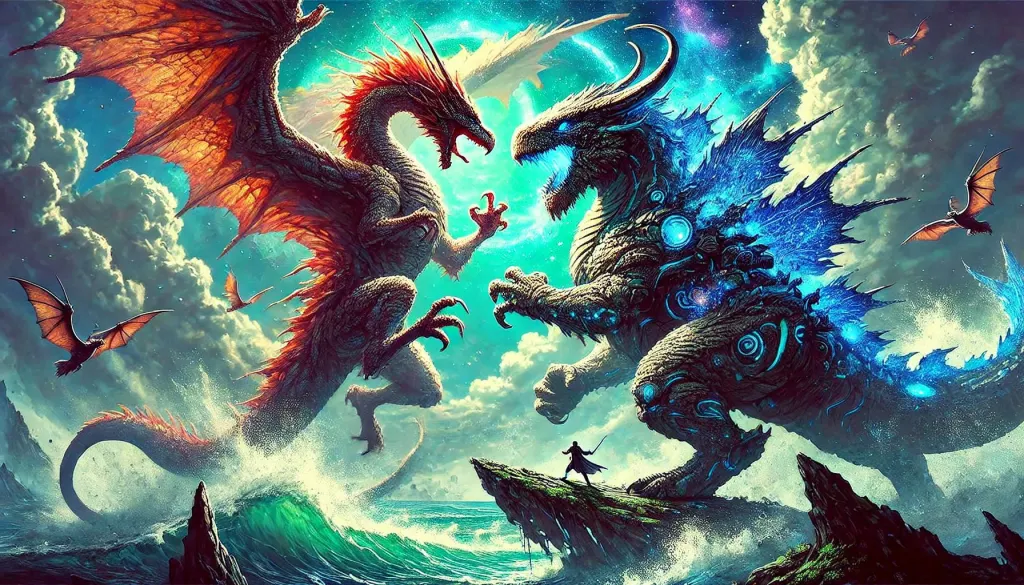
Now this is a legendary topic. 🐉 Dragons have been slithering, soaring, and scorching their way through human imagination for thousands of years—shifting forms, meanings, and temperaments across cultures and time. Let’s dive into how dragons evolved from ancient myth to modern fantasy icons.
🐍 Ancient Origins: Chaos Beasts and Primordial Forces
🌍 Mesopotamia & the Ancient Near East
- One of the earliest dragon-like creatures is Tiamat from Babylonian mythology—a chaos serpent/sea dragon defeated by the storm god Marduk.
- Tiamat represents primordial chaos, a theme echoed in many later dragon myths.
🇪🇬 Egypt
- The serpent Apep (Apophis) battled Ra every night as he journeyed through the underworld. Apep was a symbol of darkness and chaos, trying to devour the sun.
🇮🇳 India
- Vritra, a serpent or dragon, blocked rivers and brought drought until slain by the god Indra—again, a water-hoarding monster defeated by a sky god.
🔑 Common early theme: Dragons = elemental chaos, often tied to water, darkness, or destruction.
🐉 Classical and Medieval Dragons: Symbols of Power and Peril
🇬🇷 Greece
- The Greeks had drakōn (from which we get the word dragon), which were usually giant serpents. Think:
- Ladon guarding the golden apples
- The Hydra slain by Heracles
- Not flying, fire-breathing creatures—more like deadly guardians or obstacles.
🇨🇳 China
- Chinese dragons (long) are benevolent, wise, and associated with water, rain, and imperial authority.
- Unlike their Western cousins, they:
- Are wingless but can fly
- Live in the sea or sky
- Represent luck, power, and balance
🇪🇺 Medieval Europe
- Dragons become villains, often hoarding treasure or abducting maidens.
- St. George slaying the dragon becomes a Christian allegory for good vs. evil.
- These dragons are:
- Fire-breathing
- Winged and reptilian
- Often said to dwell in caves or mountaintops
🖋️ The Renaissance to the Enlightenment: Myth Meets Science
- As science and exploration expanded, people began rationalizing dragon myths as misidentified fossils or exotic animals (like crocodiles).
- Naturalists included dragons in early encyclopedias and bestiaries, often as moral symbols.
📚 Modern Fantasy: Dragons Reimagined
🔥 The 20th Century Explosion
- J.R.R. Tolkien’s Smaug (from The Hobbit) brought dragons into the modern fantasy age: intelligent, greedy, destructive.
- C.S. Lewis, Anne McCaffrey, and Dungeons & Dragons expanded the archetype:
- Dragons as rideable allies
- Good vs. evil color-coded dragons (D&D)
- Bonded, psychic connections (McCaffrey’s Dragonriders of Pern)
🐲 Today’s Pop Culture Dragons
- Daenerys’ dragons in Game of Thrones: devastating weapons and symbols of power
- Toothless from How to Train Your Dragon: loyal, emotional, adorable
- The Witcher, Elden Ring, Skyrim, World of Warcraft: dragons as epic bosses or complex characters
Now, dragons can be:
- Villains or heroes
- Pets, gods, weapons, or even metaphors (for trauma, power, addiction, etc.)
🧠 Why Do Dragons Endure?
Because they’re the ultimate shapeshifters—metaphors for:
- Nature’s power
- Greed and fear
- Wisdom and mystery
- The “other” we must face, tame, or become
Dragons can mean anything, which makes them timeless.
Want a breakdown of dragons by culture, or a guide to building your own fantasy dragon species (temperament, powers, habitats, etc.)? I’m all in. 🐉✨